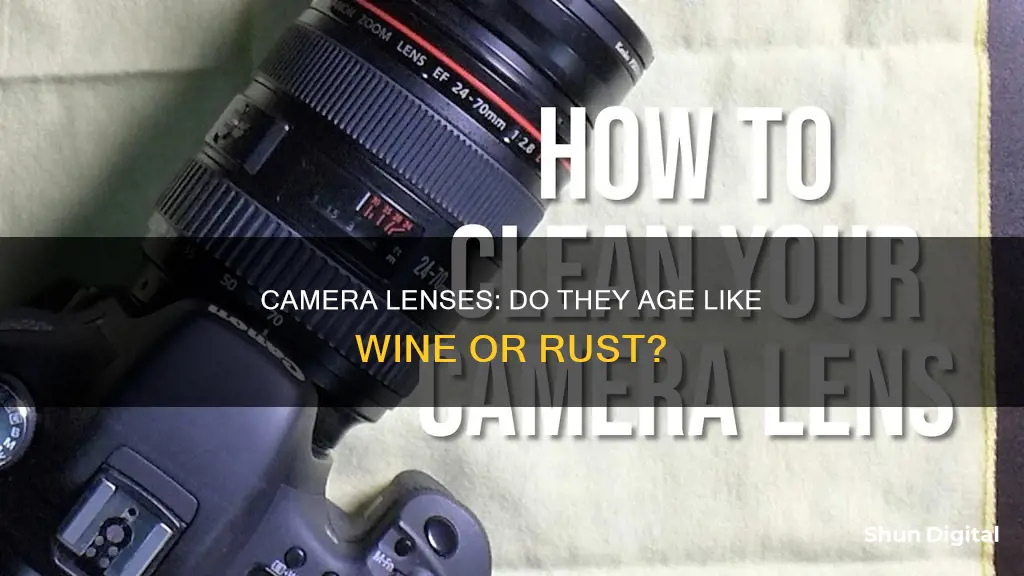
Camera lenses are made up of many components, including glass elements, electronic boards, motors, and more. While the glass elements are unlikely to warp or degrade, other parts of the lens can wear out over time or with heavy use. This includes the gold-plated contacts at the rear of the lens, which are designed for a specific number of insertions, as well as the autofocus system, zoom mechanism, and rubber parts. Additionally, lenses can be damaged by scratches, fungus, or dislocation of glass elements. Proper storage and maintenance can help extend the lifespan of a lens, but even high-end lenses will degrade if not cared for properly.
| Characteristics | Values |
|---|---|
| Do camera lenses deteriorate over time? | No, not exactly. However, the quality of the lens, usage, and storage conditions can affect its longevity. |
| Parts of a camera lens that deteriorate | Gold-plated contacts, rubber parts, autofocus system, zoom system, glass elements, ribbon cables, and other electronic components. |
| Factors that contribute to deterioration | Physical damage, humidity, heat, frequent attachment and detachment, dust, fungus, scratches, and dislocation of glass elements. |
| Ways to mitigate deterioration | Proper storage, regular cleaning, use of filters, and servicing by authorised repair centres. |
What You'll Learn

Camera lenses can be damaged by dirt, dust, and moisture
To prevent dust from entering your lens, always use lens caps when the camera is not in use, and consider using a UV filter. Store your camera in a clean, dry place, such as a camera bag, and be cautious when changing lenses to minimise dust exposure. Regularly clean your camera's exterior with a soft brush or air blower to reduce surface dust.
If dust is causing issues with your images or obstructing your view, you may need to clean the lens. It is recommended to have a professional technician clean your lens to avoid causing damage. However, if you choose to clean it yourself, you will need a clean and well-lit workspace, a compressed air blower, lens cleaning solution, a soft brush, and a microfiber lens cleaning cloth.
- Wear protective gloves to prevent fingerprints.
- Remove the front protective ring using a tool like a flathead screwdriver.
- Use a blower to remove dry dust from the inner ring surface.
- Clean the ring with a cotton swab and an optical cleaning solution.
- Unscrew and remove the front element using the appropriate tools.
- Place the element on a lined surface and cover the hole with a lens cap.
- Brush off dust with a soft brush, then clean stains with a microfiber cloth and lens cleaning solution.
- Zoom in to access internal elements and clean them with a soft brush.
- Ensure no dust remains inside the lens using a blower.
- Carefully reassemble the lens components.
It is important to avoid dusty environments when cleaning or changing lenses. Do not blow on the lens with your mouth, as the moisture from your breath can cause further issues. Additionally, refrain from using household chemicals to clean your lens, as they may damage the lens coatings or other sensitive parts.
Interchangeable Lens Cameras: Are They Worth the Hype?
You may want to see also

Camera lenses can be damaged by improper storage
Camera lenses are delicate pieces of equipment that require careful storage to ensure they remain in good condition. Improper storage can lead to various issues that can be costly to repair and will likely reduce the resale value of your lenses.
One of the most significant issues caused by improper storage is lens fungus. Fungal spores are present in the air around us and can find their way into lenses, where they grow and spread. While weather-sealed lenses offer some protection, they are not entirely spore-proof. Lens fungus excretes an acid that can damage the protective coatings of lenses and etch fine lines into the glass. Therefore, it is crucial to keep lenses dry, as fungus requires moisture to grow. Storing lenses in dry environments can help prevent the growth and spread of fungus.
In addition to fungus, corrosion or rust can develop on metal parts of lenses if they are not properly cleaned before storage. High temperatures can also cause lubrication grease to thin out and run, leading to potential issues with moving parts. Oily apertures can cause sluggish or sticky responses, potentially causing photographers to miss their shots. Heat can also degrade plastics and rubber gaskets, leading to sticky camera grips that are challenging to clean.
Improper storage can also lead to physical damage to lenses. For example, placing lenses in airtight containers with certain glues, adhesives, protective foams, paints, or solvents can release gases over time, coating lenses in haze. Additionally, storing lenses with large tripods can result in scratches or broken parts if they fall.
To avoid these issues, it is essential to store lenses properly. This includes keeping them dry, organised, and in a safe location away from children and pets. Using proper storage methods, such as closets, shelves, or cabinets, and protective cases, wraps, or bags, can help prevent damage and ensure the longevity of your lenses.
Lenses for Full-Frame Cameras: What's the Difference?
You may want to see also

Camera lenses can be damaged by fungus
Fungus inside a lens looks like small, web-like spots or patches and, if left untreated, can permanently reduce image quality, causing images to look fuzzy or hazy. It can also decrease the resale value of the camera.
To prevent fungus growth, it is recommended to keep lenses in cool, dry places and store them in see-through or humidity-controlled cabinets with silica gel packets if they will not be used for a long time. Silica gel packets absorb moisture, while see-through containers allow light inside that can kill fungus. It is also important to monitor the moisture and temperature status of the environment and wipe down any condensation that forms on camera equipment.
If fungus is suspected, the lens should be evaluated by a professional technician to determine if it can be cleaned. While it is possible to kill fungus with UV light or by cleaning it with hydrogen peroxide, disassembling the lens and cleaning the elements can be challenging and may damage the lens coatings if not done properly.
Full-Frame Lenses: Sharper on Crop Sensor Cameras?
You may want to see also

Camera lenses can be damaged by scratches
To prevent scratches, it is essential to handle lenses with care and take proactive measures. This includes using lens caps when the lens is not in use, avoiding touching the lens with your fingers, and considering the use of a protective filter. These steps can minimise the risk of scratches and help maintain the condition of your lens.
If scratches do occur, there are several methods to address them, depending on the severity. For minor scratches, a gentle approach is recommended. Using a microfiber cloth with a small amount of toothpaste or baking soda mixed with water, you can gently buff the scratch in a circular motion. Alternatively, a specialised lens cleaning solution and cloth can be used to clean the lens without causing further damage.
For deeper scratches, more intensive repair methods may be necessary. Lens repair kits are available, which typically include a polishing compound and a buffing wheel that can be attached to a drill or rotary tool. However, caution is advised when using these kits, as over-polishing can lead to further damage. In some cases, it may be best to seek the assistance of a professional repair service to ensure the lens is properly cared for.
In summary, while camera lenses are designed to be durable, they can be susceptible to scratches over time. Preventative measures are crucial to minimise this risk. If scratches do occur, a range of repair options are available, from gentle buffing for minor scratches to professional repair services for more severe cases. By taking care of your lenses and addressing scratches promptly, you can maintain their optical quality and ensure clear, sharp images.
Cleaning Camera Lenses: A Step-by-Step Guide
You may want to see also

Camera lenses can be damaged by wear and tear
For example, if you attach the camera lens to the body too many times, the gold-plated metal contacts will start to wear out. If you zoom in and out too many times, the glass elements may get dislocated by a small distance over time. The ribbon cable inside the lens may also wear out after extended use.
Camera lenses can also be damaged by the environment. If you store the camera in a humid area, the life of the rubber parts will be reduced.
In addition, dirt, sand, dust, and moisture can degrade quality. Heat or excessive use can cause all electronic devices to experience wear.
Compatibility of Pentax Lenses with Fujica Cameras
You may want to see also
Frequently asked questions
Camera lenses are made of many parts, and each of these elements is designed for a particular wear and tear rate. So, when the usage exceeds the design value, the different components of the camera lens will start to wear out. However, if cared for properly, a lens can last a long time.
Some of the factors that contribute to the deterioration of camera lenses include dust, scratches, fungus, dislocation of glass elements, wear and tear, and environmental factors such as heat and humidity.
There are several indications that your camera lens may be damaged or worn out, including scratches on the lens glass, worn-out or sticky rubber parts, autofocus not working, issues with zooming, and visible broken parts.







